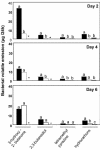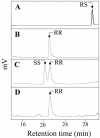Bacterial volatiles induce systemic resistance in Arabidopsis
- PMID: 14976231
- PMCID: PMC389924
- DOI: 10.1104/pp.103.026583
Bacterial volatiles induce systemic resistance in Arabidopsis
Erratum in
- Plant Physiol. 2005 Apr;137(4):1486
Abstract
Plant growth-promoting rhizobacteria, in association with plant roots, can trigger induced systemic resistance (ISR). Considering that low-molecular weight volatile hormone analogues such as methyl jasmonate and methyl salicylate can trigger defense responses in plants, we examined whether volatile organic compounds (VOCs) associated with rhizobacteria can initiate ISR. In Arabidopsis seedlings exposed to bacterial volatile blends from Bacillus subtilis GB03 and Bacillus amyloliquefaciens IN937a, disease severity by the bacterial pathogen Erwinia carotovora subsp. carotovora was significantly reduced compared with seedlings not exposed to bacterial volatiles before pathogen inoculation. Exposure to VOCs from rhizobacteria for as little as 4 d was sufficient to activate ISR in Arabidopsis seedlings. Chemical analysis of the bacterial volatile emissions revealed the release of a series of low-molecular weight hydrocarbons including the growth promoting VOC (2R,3R)-(-)-butanediol. Exogenous application of racemic mixture of (RR) and (SS) isomers of 2,3-butanediol was found to trigger ISR and transgenic lines of B. subtilis that emitted reduced levels of 2,3-butanediol and acetoin conferred reduced Arabidopsis protection to pathogen infection compared with seedlings exposed to VOCs from wild-type bacterial lines. Using transgenic and mutant lines of Arabidopsis, we provide evidence that the signaling pathway activated by volatiles from GB03 is dependent on ethylene, albeit independent of the salicylic acid or jasmonic acid signaling pathways. This study provides new insight into the role of bacteria VOCs as initiators of defense responses in plants.
Figures








Similar articles
-
Induced resistance by a long-chain bacterial volatile: elicitation of plant systemic defense by a C13 volatile produced by Paenibacillus polymyxa.PLoS One. 2012;7(11):e48744. doi: 10.1371/journal.pone.0048744. Epub 2012 Nov 28. PLoS One. 2012. PMID: 23209558 Free PMC article.
-
Systemic resistance induced by volatile organic compounds emitted by plant growth-promoting fungi in Arabidopsis thaliana.PLoS One. 2014 Jan 27;9(1):e86882. doi: 10.1371/journal.pone.0086882. eCollection 2014. PLoS One. 2014. PMID: 24475190 Free PMC article.
-
Bacterial volatiles promote growth in Arabidopsis.Proc Natl Acad Sci U S A. 2003 Apr 15;100(8):4927-32. doi: 10.1073/pnas.0730845100. Epub 2003 Apr 8. Proc Natl Acad Sci U S A. 2003. PMID: 12684534 Free PMC article.
-
Microbial volatiles as plant growth inducers.Microbiol Res. 2018 Mar;208:63-75. doi: 10.1016/j.micres.2018.01.002. Epub 2018 Jan 31. Microbiol Res. 2018. PMID: 29551213 Review.
-
Dynamic chemical communication between plants and bacteria through airborne signals: induced resistance by bacterial volatiles.J Chem Ecol. 2013 Jul;39(7):1007-18. doi: 10.1007/s10886-013-0317-9. Epub 2013 Jul 24. J Chem Ecol. 2013. PMID: 23881442 Free PMC article. Review.
Cited by
-
Characterization and evaluation of Bacillus amyloliquefaciens strain WF02 regarding its biocontrol activities and genetic responses against bacterial wilt in two different resistant tomato cultivars.World J Microbiol Biotechnol. 2016 Nov;32(11):183. doi: 10.1007/s11274-016-2143-z. Epub 2016 Sep 19. World J Microbiol Biotechnol. 2016. PMID: 27646210
-
Biological control of potato common scab and growth promotion of potato by Bacillus velezensis Y6.Front Microbiol. 2023 Dec 11;14:1295107. doi: 10.3389/fmicb.2023.1295107. eCollection 2023. Front Microbiol. 2023. PMID: 38149275 Free PMC article.
-
Isolation and Identification of Antifungal Compounds from Bacillus subtilis C9 Inhibiting the Growth of Plant Pathogenic Fungi.Mycobiology. 2012 Mar;40(1):59-66. doi: 10.5941/MYCO.2012.40.1.059. Epub 2012 Mar 31. Mycobiology. 2012. PMID: 22783136 Free PMC article.
-
High production of enantiopure (R,R)-2,3-butanediol from crude glycerol by Klebsiella pneumoniae with an engineered oxidative pathway and a two-stage agitation strategy.Microb Cell Fact. 2024 Jul 23;23(1):205. doi: 10.1186/s12934-024-02480-4. Microb Cell Fact. 2024. PMID: 39044245 Free PMC article.
-
The role of microbial signals in plant growth and development.Plant Signal Behav. 2009 Aug;4(8):701-12. doi: 10.4161/psb.4.8.9047. Epub 2009 Aug 18. Plant Signal Behav. 2009. PMID: 19820333 Free PMC article. Review.
References
-
- Alonso JM, Hirayama T, Roman G, Nourizadeh S, Ecker JR (1999) Ein2 a bifunctional transducer of ethylene and stress responses in Arabidopsis. Science 284: 2148-2152 - PubMed
-
- Alström S (1991) Induction of disease resistance in common bean susceptible to halo blight bacterial pathogen after seed bacterization with rhizosphere pseudomonads. J Gen Appl Microbiol 37: 495-501
-
- Arimura G, Ozawa R, Horiuchi JI, Nishioka T, Takabayashi J (2001) Plant-plant interactions mediated by volatiles emitted from plants infested by spider mites. Biochem System Ecol 29: 1049-1061
-
- Arimura G, Ozawa R, Shimoda T, Nishioka T, Boland W, Takabayashi J (2000) Herbivory-induced volatiles elicit defense genes in lima bean leaves. Nature 406: 512-515 - PubMed
-
- Benhamou N, Kloepper JW, Tuzun S (1998) Induction of resistance against Fusarium wilt of tomato by combination of chitosan with an endophytic bacterial strain: ultrastructure and cytochemistry of the host response. Planta 204: 153-168
Publication types
MeSH terms
Substances
LinkOut - more resources
Full Text Sources
Other Literature Sources

